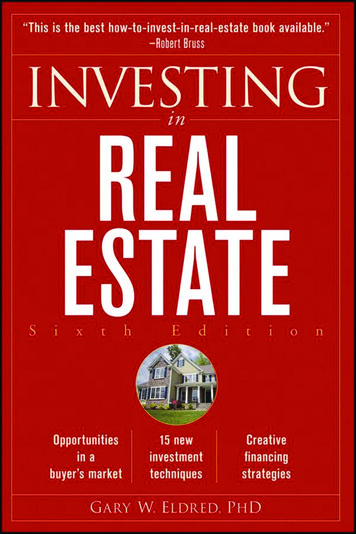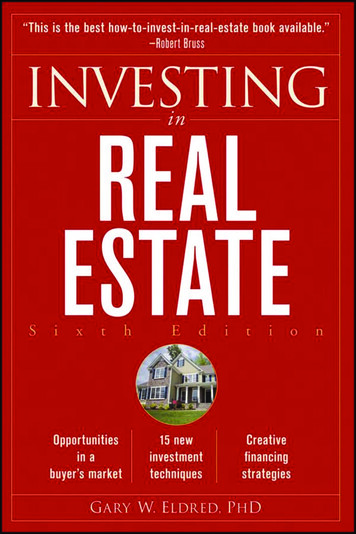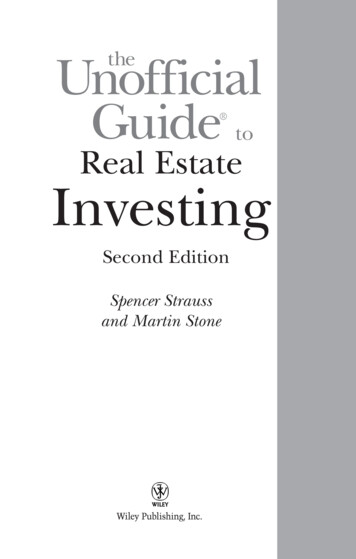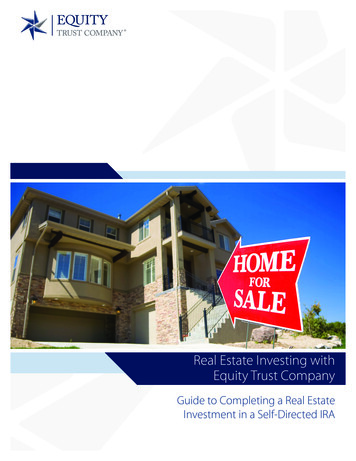
Transcription
Praise for Gary Eldred“Donald Trump and I have created Trump University to offer thehighest quality, success-driven education available. Our one goal is tohelp professionals build their careers, businesses, and wealth. That’swhy we selected Gary Eldred to help us develop our first courses inreal estate investing. His books stand out for their knowledge-packedcontent and success-driven advice.”—Michael W. Sexton, CEOTrump University“Gary has established himself as a wise and insightful real estateauthor. His teachings educate and inspire.”—Mark Victor Hansen, Coauthor,Chicken Soup for the Soul“I just finished reading your book, Investing in Real Estate, Fourth Edition. This is the best real estate investment book that I have read so far.Thanks for sharing your knowledge about real estate investment.”—Gwan Kang“I really enjoyed your book, Investing in Real Estate. I believe it’s oneof the most well-written books on real estate investing currently onthe market.”—Josh LowryBellevue, WAPresident of Lowry Properties“I just purchased about 140 worth of books on real estate and yoursis the first one I finished reading because of the high reviews it got.I certainly wasn’t let down. Your book has shed light on so manythings that I didn’t even consider. Your writing style is excellent.Thanks again.”—Rick Reumann“I am currently enjoying and learning a lot from your book, Investingin Real Estate. Indeed it’s a powerful book.”—Douglas M. Mutavi“Thanks so much for your valuable book. I read it cover to cover.I’m a tough audience, but you’ve made a fan here. Your writing iscoherent, simple, and clean. You are generous to offer the benefits ofyour years of experience to those starting out in this venture.”—Lara Ewing
INVESTINGinS i x t hE d i t i o nGARY W. ELDRED, PhDJohn Wiley & Sons, Inc.
C 2009 by Gary W. Eldred, PhD. All rights reserved.Copyright Published by John Wiley & Sons, Inc., Hoboken, New Jersey.Published simultaneously in Canada.No part of this publication may be reproduced, stored in a retrieval system, ortransmitted in any form or by any means, electronic, mechanical, photocopying,recording, scanning, or otherwise, except as permitted under Section 107 or 108of the 1976 United States Copyright Act, without either the prior writtenpermission of the Publisher, or authorization through payment of theappropriate per-copy fee to the Copyright Clearance Center, Inc., 222 RosewoodDrive, Danvers, MA 01923, (978) 750-8400, fax (978) 646-8600, or on the web atwww.copyright.com. Requests to the Publisher for permission should beaddressed to the Permissions Department, John Wiley & Sons, Inc., 111 RiverStreet, Hoboken, NJ 07030, (201) 748-6011, fax (201) 748-6008, or online athttp://www.wiley.com/go/permissions.Limit of Liability/Disclaimer of Warranty: While the publisher and author haveused their best efforts in preparing this book, they make no representations orwarranties with respect to the accuracy or completeness of the contents of thisbook and specifically disclaim any implied warranties of merchantability orfitness for a particular purpose. No warranty may be created or extended bysales representatives or written sales materials. The advice and strategiescontained herein may not be suitable for your situation. You should consultwith a professional where appropriate. Neither the publisher nor author shall beliable for any loss of profit or any other commercial damages, including but notlimited to special, incidental, consequential, or other damages.For general information on our other products and services or for technicalsupport, please contact our Customer Care Department within the United Statesat (800) 762-2974, outside the United States at (317) 572-3993 or fax (317)572-4002.Wiley also publishes its books in a variety of electronic formats. Some contentthat appears in print may not be available in electronic books. For moreinformation about Wiley products, visit our web site at www.wiley.com.Library of Congress Cataloging-in-Publication Data:Eldred, Gary W.Investing in real estate / Gary W. Eldred.—6th ed.p. cm.Includes index.Rev. ed. of: Investing in real estate / Andrew J. McLean and Gary W. Eldred.5th ed. 2006.ISBN 978-0-470-49926-91. Real estate investment—United States. I. McLean, Andrew James.Investing in real estate. II. Title.HD255.M374 2009332.63 24—dc222009023124Printed in the United States of America.10 9 8 7 6 5 4 3 2 1
CONTENTSPrologue: Invest in Real Estate Now!Acknowledgmentsxixxxvii1 WHY INVESTING IN REAL ESTATE PROVIDESYOU THE BEST ROUTE TO A PROSPEROUSFUTURE22 Sources of Returns from Investment PropertyWill the Property Experience Price Gains from Appreciation?134Will You Gain Price Increases from Inflation?Earn Good Returns from Cash FlowsMagnify Your Price Gains with Leverage566Magnify Returns from Cash Flows with LeverageBuild Wealth through AmortizationOver Time, Returns from Rents Go UpRefinance to Increase Cash Flows7789Refinance to Pocket CashBuy at a Below-Market PriceSell at an Above-Market-Value PriceCreate Property Value Through Smarter ManagementCreate Value with a Savvy Market Strategy1010101111v
viCONTENTSCreate Value: Improve the LocationConvert from Unit Rentals to Unit OwnershipConvert from Lower-Value Use to Higher-Value Use121212Subdivide Your Bundle of Property RightsSubdivide the Physical Property (Space)Create Plottage (or Assemblage) ValueObtain Development/Redevelopment RightsTax Shelter Your Property Income and Capital GainsDiversify Away from Financial Assets131414151516Is Property Always Best?2 FINANCING: BORROW SMART, BUILD WEALTH1618The Birth of “Nothing Down”Should You Invest with Little or No Cash or Credit?1819What’s Wrong with “No Cash, No Credit, No Problem”?Leverage: Pros and ConsWhat Are Your Risk-Return Objectives?Maximize Leverage with Owner-Occupancy Financing20222728Owner-Occupied Buying StrategiesCurrent Homeowners, Too, Can Use This Method2829Why One Year?Where Can You Find High-LTV Owner-OccupiedMortgages?What Are the Loan Limits?29High Leverage for Investor-Owner Financing32High Leverage versus Low (or No) Down PaymentCreative Finance RevisitedAre High-Leverage Creative-Finance Deals Really Possible?What Underwriting Standards Do Lenders Apply?CollateralLoan-to-Value RatiosRecourse to Other Assets/IncomeAmount and Source of Down Payment and Reserves3232383940404141Capacity (Monthly Income)303042
CONTENTSviiCredit History (Credibility!)Character and CompetencyCompensating Factors434445Automated Underwriting (AUS)463 APPRAISAL: HOW TO DISCOVER GOOD VALUE47Make Money When You Buy, Not Just When You SellWhat Is Market Value?Sales Price Doesn’t Necessarily Equal Market Value484849Sound Underwriting Requires Lenders to Loan OnlyAgainst Market ValueHow to Estimate Market ValueProperty DescriptionIdentify the Subject Property50515252NeighborhoodSite (Lot) Characteristics5259ImprovementsThe Cost ApproachCalculate Cost to Build NewDeduct DepreciationLot Value6061616162Estimate Market Value (Cost Approach)The Comparable Sales Approach6364Select Comparable PropertiesApproximate Value Range—Subject PropertyAdjust for DifferencesExplain the Adjustments64656566The Income Approach67Income CapitalizationNet Operating IncomeEstimate Capitalization Rates (R)Compare Cap RatesThe Paradox of Risk and Appreciation PotentialCompare Relative Prices and Values696972727374
viiiCONTENTSValuation Methods: Summing UpAppraisal Limiting ConditionsValuation versus Investment Analysis4 MAXIMIZE CASH FLOWS AND GROWYOUR EQUITYWill the Property Yield Good Cash Flows?Arrange Alternative Terms of FinancingDecrease (or Increase) Your Down PaymentBuy at a Bargain PriceShould You Ever Pay More than Market Value for aProperty?The Debt Coverage RatioNumbers Change, Principles RemainWill the Property Yield Profitable Increases in Price?747576777779808283848585Low-Involvement versus High-Involvement InvestingCompare Relative Prices of Neighborhoods (Cities)Undervalued Neighborhoods and CitiesBeverly Hills versus Watts (South Central Los Angeles)Demographics8687888889Accessibility (Convenience)Improved (Increased) Transportation Routes9090JobsTaxes, Services, and Fiscal SolvencyNew Construction, Renovation, and RemodelingLand-Use Laws91919192Pride of PlaceSales and Rental TrendsSumming Up5 HOW TO FIND BARGAIN-PRICED PROPERTIESWhy Properties Sell for Less (or More) Than Market ValueOwners in DistressThe “Grass-Is-Greener” Sellers93939596969797
CONTENTSixStage-of-Life SellersSeller IgnorancePrepare Screening Criteria9899100Bargain SellersNetworking/Get the Word OutNewspapers and Other PublicationsCold Call OwnersAgent ServicesInternet Listings101102102103105107Seller DisclosuresThe Disclosure Revolution107108Income PropertiesSummary1081096 PROFIT WITH FORECLOSURESThe Foreclosure ProcessLender Tries to Resolve ProblemFiling Legal NoticeThe Foreclosure SaleREOs110110111111112112Buy Preforeclosures from Distressed OwnersApproach Owners with EmpathyThe Difficulties of Dealing Profitably with Owners inDefaultPrequalify Homeowners and Properties113115Finding Homeowners in Default (Prefiling)NetworkingMortgage Collections PersonnelDrive NeighborhoodsFind Homeowners (Postfiling)117117117117118Cultivate a Relationship with Property OwnersTwo More IssuesVacant Houses112113118119120
xCONTENTSSatisfy Lenders and Lien HoldersAll Parties Are Better OffWin by Losing Less121123123Profit from the Foreclosure AuctionWhy Foreclosures Sell for Less than Market ValueMake the Adverse Sales Efforts Work for YouHow to Arrange FinancingThe Foreclosure Sale: Summing Up1241241251261277 PROFIT FROM REOs AND OTHERBARGAIN SALES128Bad News For Sellers/Builders, Good News For YouHow to Find REOs128129Follow Up with Lenders after Foreclosure SalesLocate Specialty RealtorsHUD Homes and Other HUD Properties129130131Homeowners versus Investors“As-Is” ConditionPotential Conflict of InterestBuyer Incentives132132133133The Bid PackageDepartment of Veterans Affairs (REOs)134134Big Advantages for InvestorsFannie Mae and Freddie Mac REOsAgent ListingsInvestors InvitedFederal Government Auctions135136136137137Buy from Foreclosure SpeculatorsProbate and Estate SalesProbateEstate SalesPrivate Auctions138138138139139How to Find Auctions141
CONTENTS8 QUICK PROFITS THROUGH FIX AND FLIPFix, Flip, Profit!Look for “Fixers”The Browns Create Value in a Down MarketResearch, Research, ResearchImprovement PossibilitiesThoroughly Clean the PropertyAdd Pizzazz with Color Schemes, Decorating Patterns,and FixturesCreate Usable SpaceCreate a ViewCapitalize on Owner NearsightednessEliminate a Negative ViewEnhance the Unit’s Natural LightReduce NoiseRequired Repairs and ImprovementsPlumbingElectrical SystemHeating and Air-ConditioningWindowsAppliancesWalls and CeilingsDoors and LocksLandscapingStorage AreasClean WellSafety and HealthRoofsImprovements and AlterationsYou Can Improve Everything about a Property—IncludingIts LocationThe South Beach Example: From Derelicts to FashionModelsCommunity Action and Community Spirit Make aDifferenceNeighborhoods Offer 4155156
xiiCONTENTSWhat Types of Improvements Pay the Greatest Returns?How Much Should You Budget for Improvements?Beware of Overimprovement157157158Other BenefitsNo-No ImprovementsBudgeting for Resale ProfitsEstimate the Sales Price FirstEstimate CostsFuture Sales Price Less Costs and Profit EqualsAcquisition PriceComply with Laws and RegulationsShould You Buy a “Fixer”?Too Little Time?Put Your Creativity to Work1581591591591609 MORE TECHNIQUES FOR HIGH YIELDSAND QUICK PROFITSLease OptionsHere’s How Lease Options WorkBenefits to Tenant-Buyers (An Eager Market)Benefits to InvestorsThe Lease Option SandwichHow to Find Lease Option Buyers and Sellers160162162163163165165165166167168169A Creative Beginning with Lease Options(for Investors)Lease Purchase Agreements“Seems” More DefiniteAmount of the Earnest Money DepositContingency Clauses170170171171171ConversionsCondominium ConversionTenants in CommonConvert Apartments to Office Space172172174175
CONTENTSMaster LeasesAssignments: Flipping Purchase ContractsSummary10 NEGOTIATE A WIN-WIN AGREEMENTxiii176178179180Win-Win PrinciplesThe Purchase ContractNames of the Parties181183184Site DescriptionBuilding Description184184Personal PropertyPrice and FinancingEarnest Money DepositQuality of Title185185186187Property ConditionPreclosing Property Damage (Casualty Clause)187188Closing (Settlement) CostsClosing and Possession DatesLeasesContingency ClausesAssignment and Inspection189189190191192Public Records193Systems and AppliancesEnvironmental HazardsNo RepresentationsDefault Clause193193194194Summary11 MANAGE YOUR PROPERTIES TO INCREASETHEIR VALUEThe 10:1 Rule (More or Less)Think FirstKnow Yourself197199199200201
xivCONTENTSKnow Your FinancesKnow Your CapabilitiesSmart Strategic Decisions201202202Local Markets Require Tailored StrategiesCraig Wilson’s Profit-Boosting Market StrategyHow Craig Wilson Used Market Information to Enhancethe Profitability of His PropertyResultsCut Operating Expenses203203206210210Energy AuditsProperty InsuranceMaintenance and Repair CostsProperty Taxes and Income TaxesIncreasing Value: Final Words21021121421421512 DEVELOP THE BEST LEASE216The Mythical “Standard” LeaseYour Market Strategy216216Search for Competitive AdvantageCraft Your Rental AgreementNames and Signatures218219219Joint and Several LiabilityGuestsLength of TenancyHoldover Tenants (Mutual Agreement)219220220220Holdover Tenants (without Permission)Property Description221221Inventory and Describe Personal PropertyRental AmountsLate Fees and DiscountsMultiple Late PaymentsBounced Check Fees and TerminationTenant “Improvements”221222222222223223
CONTENTSxvOwner AccessQuiet EnjoymentNoxious Odors223224224Disturbing External InfluencesTenant InsuranceSublet and AssignmentPetsSecurity DepositsYard Care224225225226226228Parking, Number, and Type of VehiclesRepairs228228Roaches, Fleas, AntsNeat and CleanRules and RegulationsWear and TearLawful Use of Premises229229229230230Notice230Failure to DeliverUtilities, Property Taxes, Association FeesLiquid-Filled FurnitureAbandonment of Property231231231232Non-waiversBreach of Lease (or House Rules)No Representations (Full Agreement)232232233ArbitrationAttorney Fees (Who Pays?)Written Notice to RemedyTenants Rights Laws233234235235Tenant SelectionProperty OperationsEvictionsLandlording: Pros and ConsPossibilities, Not ProbabilitiesProfessional Property Managers235237237238238238
xviCONTENTS13 CREATE SALES PROMOTIONS THATREALLY SELL240Design a Winning Value PropositionYet Generic PrevailsUSP versus WVPCraft Your Selling Message240240241243Use a Grabber Headline/LeadReinforce and ElaborateAdd Hot ButtonsEstablish CredibilityCompare to Substitutes244244244245245Evoke Emotional AppealReduce Perceived Risks245245Make It Easy for Prospects to RespondFollow Up with Your ProspectsReach Potential BuyersFor Sale SignsFlyers/BrochuresNetworking (Word of Mouth)Web Sites/LinksSales AgentsShould You Employ a Realty Agent?Services to SellersServices to BuyersCo-Op SalesListing Contracts14 PAY LESS TAX245247247247248249249249249250251252252255The Risks of Change and Complexity255Homeowner Tax SavingsCapital Gains without TaxesRules for Vacation HomesMortgage Interest Deductions256256257258
CONTENTSxviiCredit Card InterestRules for Your Home OfficeDepreciation Expense258259259Land Value Is Not DepreciableLand Values Vary WidelyAfter-Tax Cash FlowsPassive Loss RulesTaxpayers in the Real Property Business (No PassiveLoss Rules)259260260261262Alternative Minimum TaxCapital GainsA Simplified ExampleThe Installment SaleWhat’s the Bottom Line for Sellers?Implications for Buyers262263263264265265Tax-Free ExchangesExchanges Don’t Necessarily Involve Two-Way Trades265266The Three-Party ExchangeExchanges Are Complex but EasyAre Tax-Free Exchanges Really Tax Free?Section 1031 Exchange Rules266266268268Reporting Rental Income and Deductions269Tax CreditsComplexity, Tax Returns, and AuditsUse a Tax Pro271272275Property TaxesSummary27627815 MORE IDEAS FOR PROFITABLE INVESTING280Lower-Priced AreasWhat about Property Management?Tenant-Assisted Management281283283Property Management Companies283
xviiiCONTENTSEmerging Growth AreasThe Creative ClassImplications for Investing in Real Estate284284284Right Place, Right TimeEmerging Retirement/Second-Home AreasWhich Cities and Areas?Income InvestingCommercial PropertiesProperty Management285285286286286287The Upside and DownsideOpportunity for High Reward287287Commercial Leases Create (or Destroy) ValueTriple Net (NNN)Self-StorageMobile Home ParksProfitable Possibilities with Zoning289290291292294Tax Liens/Tax Deeds294Localities DifferAre Tax Liens/Tax Deeds an Easy Way to MakeBig Profits?Discounted Paper294What Is Discounted Paper?295Here’s How It WorksBroker the NoteDo Such Deals Really Occur?296296296Due Diligence IssuesShould You Form an LLC?Different Strokes for Different FolksInsufficient Court RulingsOne Size Doesn’t Fit All16 AN INCOME FOR LIFELess RiskPersonal OpportunityIndex295295296297297297298299301301304
PrologueINVEST IN REAL ESTATE NOW!early everywhere I speak these days, someone from the audienceasks, “Do you feel the real estate market will drop further? Havewe reached bottom yet? When do you think property prices willfully recover?”I answer, “I do not know. I really do not care. And neither shouldyou.”Why do I give such seemingly flip answers? First, because they aretrue. All investment pros encourage you to focus on your wealth-buildinggoals—not profit maximization per se. Waiting for the bottom merely givesyou an excuse to procrastinate. I’ve seen would-be investors make thismistake a thousand times.And second, because the questions are ill-formed. They miss identifying the multiple ways that you can profit with property. To investsuccessfully in real estate, you need not, and should not, focus on predicting market valleys (or peaks). More productively, think in terms ofpossibilities, probabilities, and strategy—not merely the lowest price.NWHAT ARE YOUR POSSIBILITIES?If you asked financial journalists (or their quotable experts) whether youshould now invest in real estate, you would likely receive a variety ofanswers. But nearly all of their answers would focus on one central point:the expected direction of short-term price movements.Journalists and their media molls love to play the game of shortterm forecasting. They do it with stocks, gold, commodities, interest rates,and, for the past 10 years, properties. Are prices climbing? Buy. Are pricesxix
xxPROLOGUEfalling? Get out and go sit on the sidelines. As a result of their obsessionwith short-term price movements, the media have distorted and confusedthe idea of investing in real estate.In contrast to media hype, the most experienced and successful realestate investors do not weight their deal analysis with any significantemphasis on short-term price forecasts. Instead, we typically look to aninvesting horizon of three to 10 years (or longer). More important, werealize that in addition to price increases, property provides us with manypossible sources of return. Here are some (but certainly not all) of theseprofit possibilities. Earn price gains from appreciation.Earn price gains from inflation.Create unleveraged cash flows.Use leverage to magnify returns from price gains.Use leverage (financing) to magnify returns from cash flows.Grow equity gains through amortization.Refinance to increase cashflowsRefinance to generate cash (lump sum).Buy at a below-market-value price.Sell at an above-market-value price.Create value through smarter management.Create value through savvy market strategy.Create value by improving the location.Subdivide your bundle of property rights.Subdivide the physical property.Create plottage (assemblage) value.Convert the use (e.g., residential to offices, retail to offices).Convert type of tenure (e.g., rental to ownership).Shelter income from taxes.Shelter capital gains from taxes.Create and sell development/redevelopment rights.Diversify away from stocks and bonds.I explain each of these possible sources of return in Chapter 1 andthen illustrate and elaborate to varying degrees in the chapters that follow.With this extensive range of possibilities in view, you can always findprofitable ways to invest in real estate.Unlike investing (or speculating) in stocks, bonds, gold, or commodities, you can generate returns from properties through research, reasoning,knowledge, and entrepreneurial talents. In contrast, when you buy stocks,
PROLOGUExxiyou had better pray that the market price goes up, because that’s your onlypossibility to receive a reasonable return. WHAT ARE YOUR PROBABILITIES?In the correction part of the real estate cycle, fear looms. Cash balances inbanks build up. Investors and savers join in a flight to quality. They willingly accept certificates of deposit (CDs) that pay low-single-digit interestrates. Investors think, “Who cares about return on capital? I just want tofeel confident that I receive a return of capital.In his highly regarded book The Intelligent Investor, Benjamin Grahamcreated the parable of Mr. Market. Mr. Market represents that crowd mentality whose moods swing like a pendulum from irrational exuberanceto bewildered fear and confusion. Which market mood provides the bestinvestment opportunities/possibilities? Which market mood throws investors the highest amount of actual risk? Which market mood corresponds to the least amount of actual risk?Booms Increase Actual RiskYou know the answers. During the irrationally exuberant boom times, investors perceive little risk, but actual risks loom larger and larger as pricesclimb higher and higher, income yields fall, and unsustainable amounts ofmortgage debt pile up.In Las Vegas, so-called investors (actually speculators) believed thatflipping properties paved their way to wealth. Few perceived that theirproperty risks actually laid down poorer odds than the slots at Harrah’s.And who but a fool (or Panglossian optimist) would borrow money toplay the slots? Yet Las Vegas property buyers loaded up with excessivelyhigh loan-to-value (LTV) ratios of 90, 95, and 100 percent (or more). Theymerely assumed that the future would continue to pay off as they hadexperienced in the recent past.On many of their properties, loan payments (principal, interest, taxes,and insurance [PITI]) approached 2,000 a month. Potential rents for thesame properties would reach no more than 1,200 a month. When analligator is chewing your leg off, you are in a world of danger (and aworld of hurt). As I have written in nearly every one of my books, highdebt, low income yields, and exaggerated hopes for outsized continuing With property, I have earned per annum returns of 25 percent or more—withouta single dollar of price gain.
xxiiPROLOGUEincreases in price (for either stocks or properties) always trigger a reversalof fortune. (See especially my Value Investing in Real Estate, John Wiley &Sons, 2002.)The speculative buying of Las Vegas houses serves as an outsidethe-norm example. Few other areas experienced such heightened frenzyamong both builders and buyers. Nevertheless, irrational exuberanceinfested the moods and minds of property buyers throughout manyof the world’s principal cities (though during the boom of late, notDallas, Berlin, or Tokyo—each had suffered its own irrationally exuberant property market 15 to 20 years back, and sat out this most recentparty). In nearly every instance, borrowed money fueled property pricesupward without commensurate growth in rent collections or personalincomes.Market Corrections Vanquish Market RiskWithin a few short years, many property markets have shifted from sellers’ markets driven by loose lending and buoyant dreams of fast, easymoney to buyers’ markets sustained by stricter credit standards, recordnumbers of foreclosures, a 25-year high in unemployment, and multiplemajor banks taking hits for unprecedented amounts of losses. No wonderfear and confusion have chased many potential property investors out ofthe game.So here is the 64,000 question: How should you interpret these andother dismal facts from the dismal science? Do lousy economic conditionsdiminish your chance to build a prosperous and secure future by investingin property? Or do they vanquish market risk?To make this question of risk easier, first address the following 10issues. When is the best time to acquire investment property:1. (a) When builders are bringing to market near-record numbersof new houses, condominiums, and condominium conversions,or (b) when new housing starts have fallen to the lowest levelsince before 1959?2. (a) When buyers flock to open houses and beg sellers to accepttheir above-asking-price bids, or (b) when investors and homebuyers remain relatively scarce?3. (a) After economic recovery pushes interest rates higher, or(b) when interest rates sit near the low end of the past 40 years?4. (a) When inflation seems subdued (as occurred during thepast eight years), or (b) (as today) when massive amounts of
PROLOGUE5.6.7.8.9.10.xxiiigovernment borrowing and huge increases in the money supplyseem sure to push inflation (and interest rates) to higher levelswithin the coming decade?(a) When properties sell for prices at a 20 to 50 percent premiumabove their replacement costs, or (b) when you can buy propertiesat a 20 to 50 percent discount below their replacement costs?(a) When millions of home buyers overleverage to purchasehouses that they cannot afford, or (b) when stricter credit andhigh unemployment lead many people to double up (or eventriple up) on their housing?(a) When most sellers can hold out for top dollar, or (b) whenfinancial distress and more than one million foreclosures/REOscreate millions of desperately motivated sellers?(a) When property prices sit in the clouds well above the levelthat rents will support, or (b) when market values fall to thepoint where income yields make sense and investors can reasonably expect to achieve positive cash flows—either immediatelyor within a few years?(a) When hundreds of thousands of new investors overleveragethemselves to buy rental properties that they do not know howto manage, or (b) when those same starry-eyed investors rudelyawaken to the fact that successful investing requires reserves ofcash and credit, knowledge, thought, and an operating systemand strategy?(a) When economic recovery and increasingly positive news propel millions of backbenchers into the game, or (b) now?If you’ve answered (b) to each of these 10 issues, you display thecourage and foresight to become a great investor. You know that marketcorrections vanquish risk and multiply your possibilities for profit.Never Wait for Market Peaks or BottomsTo invest successfully, never try to time a market bottom—or a market top.Neither you, I, nor anyone else can develop that skill. Why? Because moreoften than not, random events trigger short-term turns in markets. Wecan tell when markets are becoming too pricey. We can tell when marketconditions greatly favor investors. But only by extraordinary luck can wepick the one best time to sell or buy. (Just as importantly, the way younegotiate a deal can create as much or more opportunity for you than themarket conditions themselves.)
xxivPROLOGUEMy Texas Example I owned properties in Texas in the early 1980s. Bymid-1984, I had sold all of them (at substantial gains). The market continued to go up. Property agents told me that I shouldn’t have sold. Later,after the crash in 1985, they told me that I had sold too soon. What do youthink?When do you replace the tires on your car? At the last possiblemoment before they blow out? Or when you see the tread wearing downand the risk of a blowout increasing? If you want to save your life, do nottry to run your tires until the last possible moment.Likewise with property, when irrational exuberance fuels prices everhigher and these prices are unsupported by rent levels or personal income growth, risk builds excessively. Prudence sells to save profits. Onlyfools hold on to capture the last dollar—or the last 1,000 miles from thatrisky, worn tire. And only bigger fools believe that tires or booms will lastforever.Look for Solid Value—Not Necessarily a Market Bottom or Market BoomToday’s markets offer multiple low-risk, high-profit possibilities. Overa time horizon of three to five years—if you follow the principles laidout in this book—you will enjoy strong profits. I encourage you to getin the game now. No one can predict the course of prices during thenext year or two. But today, you can certainly find solid values in mostmarkets.In my experience, two major mistakes prevent people from profitingwith property: (1) They wait too long to exit an irrationally exuberantmarket, and (2) they wait too long to take advantage of the possibilitiesthat are theirs for the taking.DEVELOP AND EXECUTE YOUR STRATEGY NOWAs you read through the following pages, you will discover how propertyprovides at least 22 sources of financial returns. Plus, you will discovermultiple ways to harvest those returns.Buying, improving, and holding income properties—especiallywhen you purchase them at bargain prices and finance with smartleverage—offers the surest, safest, and, yes, even the quickest way to buildwealth. But even long-term investors such as myself will venture alongother avenues when clear opportunities arise.In addition to the buy, improve, and hold approach, other techniques include discounted paper, real estate investment trusts (REITs),
PROLOGUExxvcondominium conversions, fix and flip, adaptive reuse, tax liens, mobilehome parks, self-storage centers, lease options, triple net leases, and otherpossibilities to profit through property.If you want a secure f
Investing in real estate / Gary W. Eldred.—6th ed. p. cm. Includes index. Rev. ed. of: Investing in real estate / Andrew J. McLean and Gary W. Eldred. 5th ed. 2006. ISBN 978-0-470-49926-9 1. Real estate investment—United States. I. McLean, Andrew James. Investing in real est










